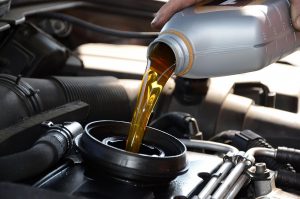The 6 Fluids Your Vehicle Craves the Most
Cars are thirsty beasts. Without enough fluid to keep their parts lubricated, they would quickly dry up and stop functioning properly. If you would rather not find yourself stranded on a lonely desert highway in the middle of a blazing hot day or a freezing cold night, then it’s important to check your car’s fluids regularly.
So, what kind of fluids do you need, how much do you need, and when do you need to head to the nearest full-service car wash to replace them? Use this handy fluid checklist to make sure you’re staying up to date.
Engine Oil
Every driver knows (or should know, at least) that they need to check and replace their engine oil on a regular basis. Oil is not only the most well-known vehicle fluid but also the most important.
What: Engine oil lubricates all those moving parts. Without it, your engine would wear down, overheat, rust, and get clogged with dirt particles.
When: Experts recommend checking the oil once a month in order to be safe. Add new oil whenever the current levels are low. Replace the existing oil if it appears old or dirty. Your vehicle’s manual should give you a rough estimate of how often you should be changing the oil.
How: Each vehicle is different. It’s important to read the owner’s manual for your car or truck to make certain you’re checking the oil correctly. That being said, the following steps are fairly universal:
- Step #1: Drive your car around the block. A short drive will get the oil circulating.
- Step #2: Let the car cool down before you open the hood. You don’t want to burn yourself while touching the engine the parts. Tip: Leave the engine off for at least 10 minutes before working with the engine.
- Step #3: Remove the oil dipstick. Wipe it clean with a cloth, put it back, and then pull it out again. Tip: Make sure you’ve got the oil stick and not the transmission fluid stick.
- Step #4: Check the oil level. There should be notches in the stick that give you an indication of where the oil should be. If the fluid comes up far enough, you’re good to go. If not, then it’s time to add some new oil. Tip: Consult your vehicle’s manual to determine what a safe level looks like.
- Step #5: Check the quality of the oil. Many people check the volume but forget to inspect the quality. Don’t worry about the color—all oil turns black in a fairly short amount of time. Instead, rub a little of the oil between your fingers. If it stays on your skin, leaving behind a dirty smudge, then it may be time to change out the oil. Tip: When in doubt, consult a professional at the closest car wash or auto repair shop.
Transmission Fluid
Engine oil may be the most important fluid, but it’s not the only one your car needs to function properly. Transmission fluid is just as critical if you want to keep driving down Arizona’s highways without a hitch.
What: Transmission fluid lubricates the gears. Just like engine oil, it reduces wear and tear while preventing overheating. It also provides the hydraulic power needed to power the gears. Unlike engine oil, transmission fluid is never depleted. That’s because it’s part of a closed system, which means your car or truck should never ever run low. If you do see signs of reduced volume, then something is wrong, and it’s best to consult a mechanic right away.
When: You should also check your transmission fluid every month, primarily for quality instead of quantity. Once again, each vehicle is different, but a general rule of thumb is to replace the fluid after you’ve driven 50,000-100,000 miles.
How: You can inspect the transmission fluid by pulling out the other dipstick. You can usually check it in the same way you would check your engine oil dipstick, although you are primarily looking for signs of reduced quality rather than reduced volume.
Good quality fluid will look clear, pinkish, or even red, but certainly not brown. If it does look brown or if it gives off a burnt smell, you’ll need to visit the local mechanic or search for a “full-service car wash near me” to get your transmission fluid flushed and replaced.
Radiator Fluid
Some people call it coolant. Others call it antifreeze. Others refer to it as radiator fluid. Whatever you call it, this fluid protects your vehicle from the destructive effects of  weather and overuse.
weather and overuse.
What: Radiator fluid prevents your car or truck from overheating either because of hot weather or from its own natural heat. It also keeps your engine from freezing in the winter. It does its job by simultaneously lowering the freezing temperature and the boiling temperature of the water that circulates through your engine.
When: Checking the radiator fluid twice a year—before the temperature drops in the winter and before it rises again in the summer—is sufficient to guard against freezing or overheating. Most car owners will have to replace their coolant every two to three years.
How: As always, check your owner’s manual to go over the specifications for your vehicle.
- Step #1: Pop the radiator cap to check the fluids inside. Tip: Once again, make sure your engine has been off for at least 10 minutes before you open the hood and touch the engine.
- Step #2: You can check the volume simply by looking in the radiator and seeing how fluid there is left. There should be a mark that delineates an acceptable level. If the fluid drops below this line, then it’s time for an extra dose. Tip: Don’t mix and match fluids. Add only the same type of radiator fluid that is already in the vehicle.
Brake Fluid
A vehicle that can’t stop on a dime endangers your life, as well as the lives of any passengers that may be along for the ride. Checking your brake fluid on schedule should,  therefore, be a top priority.
therefore, be a top priority.
What: Without the pressurized power supplied by the brake fluid your brakes would stop working or would work poorly, which can be just as dangerous. Just as with your transmission fluid, your brake fluid is part of a closed system. That means you should never run out. As long as everything is running properly, there should be no reduction in volume.
When: Check the brake fluid every time you check your engine oil. You should also pop the hood anytime something feels even slightly wrong when you press the brakes. If they feel sluggish or unresponsive, it’s definitely time to do a system’s check.
How: It’s fairly easy for the mechanically inclined to check the brake fluids, although you might consider getting a professional at the local car wash or auto shop to do it if you feel a little uneasy. Read the DMV’s tips on changing brake fluid before starting.
- Step #1: Pop the hood and look at the back of the engine compartment to find the brake fluid reservoir.
- Step #2: Unscrew the cap. Some reservoirs come with an additional feature: a clamp that must be popped off with a screwdriver. Tip: Wipe down the outside of the tank before opening it. You don’t want any dirt to get into the reservoir and mix with your brake fluid.
- Step #3: Simply look inside the reservoir to check both volume and quality. The fluid should nearly fill the tank (at least within a half an inch of the top). It should also have a relatively light color. If the fluid is dark or if the levels seem too low, call a mechanic.
Power Steering Fluid
Don’t risk losing control of your vehicle. Check your power steering fluid to make sure you drive your car and not the other way around.
What: Like all the other liquids in your car, power steering fluids has an important job: lubrication. This fluid, however, works on the steering system and makes it easier for drivers to direct those front wheels. If you’ve ever felt that tell-tale “creaking” in the steering wheel, then you’ve most likely suffered from low fluid levels.
When: Once a month is sufficient. If you do hear a strange noise or if the wheel seems a bit difficult to handle, then it’s also time to run a quick inspection.
How: Run through your manual to find the reservoir. Typically, a quick look at the fluid levels will give you an accurate picture. If you’re unsure, take the vehicle in for a quick inspection.
Differential Fluid
It’s the unsung hero of car fluids. Few people know about differential fluid, yet failing to replace it when needed can lead to some major headaches down the road.
What: Differential fluid lubricates the part of your car that helps your tires stay on the road when you turn a corner.
When: Experts recommend switching out the oil every 30,000 to 50,000 miles or whenever your owner’s manual instructs you to.
How: Unless you’re great with cars and know yours inside out, you’ll want to call a professional for this one.
Checking Your Fluids the Easy Way
Checking your fluids is easier than ever with Cobblestone Auto Spa in the neighborhood. Drop by one of our many locations in Arizona to get great prices on an oil, coolant, or transmission fluid change. If you’re having a hard time deciding which fluids your vehicle needs the most, our 18-Point Preventive Maintenance Inspection service will cover all your bases for you. We’ll examine your vehicle’s:
- Engine oil
- Coolant
- Power steering fluid
- Windshield washer fluid
- Rear and front differential fluid
- Transaxle fluid
Don’t hit the road without a good fluids check. Simply check our site to find an “automatic car wash near me” and get your vehicle back in tip-top shape.


